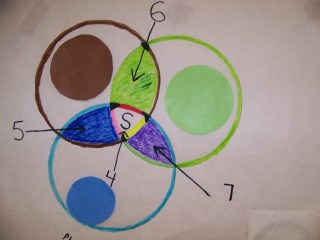The Difference That Makes The Difference
Jan. 2012
Instead of another bicycle trip post, I’m taking time out to blog another way to perceive the relationship that occurs between observer and object observed. If we are ever going to get beyond the incongruity that separates how we perceive and understand the micro and macro universe, a different model of perception, I believe, is necessary. I am not suggesting that science has it wrong. I am suggesting, though, that a more encompassing model of perception will provide science—science being how we understand the physical world–a more comprehensive and coherent platform from which to understand how the universe works. So far in my blog, I have made various attempts at describing culturally generated mystical visions, but on this bicycle trip I change direction. On this bicycle trip I talk about quantum mechanics, Relativity theory, and epistemology and that’s why I am posting the above diagram now. However, except for this post, I will not talk much about the above diagram. I am posting it only as a reference point that could be useful if questions arise. After I complete my bicycle trip, though, I will begin to use the diagram to facilitate further discussion.
To lighten things up a bit, let’s say the above diagram was created to help me write a sci-fi novella (one that remains unwritten). The novella’s plot went something like this: On a terrestrial planet that no longer supports life, some space explorers discovered a temple. Inside they found preserved texts, which, luckily, their onboard ship computer was able to translate. Fortunately, for this blog, the translated texts and the above diagram reveal the same thing—the meaning of the universe.
Okay, I may be speaking a bit tongue and cheek here, but only a little.
So back to the other story; aren’t we all looking for a means to feel secure, at home, and connected to a meaningful universe? Without trying to besmirch anybody’s religion, isn’t that what religion is all about,–to make people feel comfortable, at home, chosen, — and loved, by that which nurtured all of us into existence in the first place? Every culture produces heroes, myths, shamans, and priests, all of which breathe religious meaning into existence. Rights of passage, totem and ancestor worship, religious rites and rituals—all contribute to the how and why of existence. The “how” of existence is also considered the main subject matter of science, but that doesn’t void the “why.” Take, for instance, Albert Einstein, he did not practice any orthodox form of religion, yet, in my opinion, he was as devout as any priest. When coaxed into answering the question: “Do you believe in God?” he hesitated, and then said words to the effect, “Well if I do believe in God, it would be the God of Spinoza.” Putting challenging questions to orthodoxy, while at the same time aspiring to coherent, unifying answers to those same questions, I believe is the definition of a religious person. Before I talk more about the specifics of the above diagram, I offer one of my favorite Einstein quotes:
“Man tries to make for himself in the fashion that suits him best a simplified and intelligible picture of the world; he then tries to some extent to substitute this cosmos of his for the world of experience, and thus overcome it. This is what the painter, the poet, the speculative philosopher, and the natural scientist do, each in his own fashion. Each makes this cosmos and its construction the pivot of his emotional life, in order to find in this way the peace and security which he cannot find in the narrow whirlpool of personal experience.”
(Einstein, Ideas And Opinions, p. 225)
For me at least, the above diagram speaks directly to Einstein’s quote above, as it also speaks to the issue of why nature responds so strangely when certain questions are put to her, questions like: wave or particle? Why is the universe comprehensible as opposed to incomprehensible? Is nature independent of the observer? Why, on the quantum level, do we find a physical reality with no uniquely determinable location, a physical reality that exists in several states at the same time, a physical reality structured by a mathematical equation? Nature’s response to these questions becomes less strange, I believe, if we look through the prism of the above diagramed relationships– at the relationship that occurs between object observed and observer.
It is not that science is wrong. It is just that science is limiting itself to a small piece of a much larger picture, one when looked at in its entirety, reflects the connections that turns the perceptual process into a chain of processes which, ultimately, come together in the identification of the known world. Let me begin by labeling how I perceive the known world and then conclude this blog with some comments concerning the relevance of that perception.
Layered Sequencing Of Platforms—Reductionist, Life, Mind—That Constitute Self.
1 R—Reductionist (physical)–mass/energy platform
2 L—Life–biological/reproductive platform
3 M—Mind–symbol/meaning platform
4 S—Self— inter-subjective boundary horizons
5 Reductionist (physical/chemical environment)
6 Life (biological/emotional environment)
7 Mind (psychological/sociocultural environment of human discourse)
8 Bridge connecting physical/chemical environment to biological/emotional environment
9 Bridge connecting psychological/sociocultural level of human discourse to physical and biological environments—“self” is simultaneously in touch with all three horizons—physical (blue quadrant), biological (green quadrant), and psychological/sociocultural (purple quadrant)
For instance, when I look up from my computer screen, I see a physical world of cinder block walls (I’m at work), tile floors, furniture, colors etc. My five senses inform me of this world and science informs me that there is more to these sensations then what my five senses are telling me. The unfortunate thing about science is that, in most cases, it tries to reduce all quadrants–life and mind–to the physical platform—not possible.
The red horizon of self is a product of the overlap of the mind/life platforms—the green quadrant. This quadrant, in addition to representing life, also represents emotional life. Emotions are a defining characteristic of the plant/animal kingdom (yes, a quirky group of scientists have produced evidence that plants have feelings), but emotions are not just a product of the green quadrant. Emotions are informed by the mind and that is the difference that makes a difference. J.E. Creighton writes:
“In the development of mind, feeling does not remain a static element, constant in form and content at all levels, but…is transformed and disciplined through its interplay with other aspects of experience…Indeed, the character of the feeling in any experience may be taken as an index of the mind’s grasp of its object; at the lower levels of experience, where the mind is only partially or superficially involved, feeling appears as something isolated and opaque, as the passive accompaniment of mere bodily sensation… In the higher experience, the feelings assume an entirely different character, just as do the sensations and the other contents of mind.” (Susanne K. Langer, Philosophy in a New Key, A Study in the Symbolism of Rite, Reason, and Art, p. 100)
The yellow self-horizon is also a product of the overlap of the mind/life/reductionist platforms, but its content—the purple quadrant, is restricted to the psychological, sociocultural, self-boundary of human discourse. This purple quadrant deviates somewhat from the standard science model, which lumps the “self “into the “physical stuff” of body/brain/mind— the blue quadrant. However, there is some disagreement here. If you were to ask a “structuralist” or a “symbolic anthropologist” if the mind can stand alone, their answers would be interesting. Here’s how the philosopher, Ernst Cassirer, addressed this question:
“Man has, as it were, discovered a new method of adapting himself to his environment. Between the receptor system and the effector system, which are to be found in all animal species, we find in man a third link which we may describe as the “symbolic system.” This new acquisition transforms the whole of human life. As compared with the other animals man lives not merely in a broader reality; he lives, so to speak, in a new dimension of reality.” (An Essay On Man, p. 25)
Cassirer, also adds:
“All knowledge of the world and all strictly spiritual action upon the world require that I thrust the world back from itself, that in contemplation as in action it gain a certain distance from it. Animals do not know this distance: the animal lives in his environment; he does not place himself over against it and so represent it. This acquisition of the world as idea is, rather, the aim and product of the symbolic forms ––the result of language, myth, religion, art, and theoretical knowledge.” (Cassirer, The Phenomenology of Knowledge, p. 276)






Picture Of Self—Commentary
Adapted (loosely) from William Blake’s Songs Of Innocence And Experience
Little Structure, who made thee? Dost thou know who made thee? Gave thee life and………………….Little Structure, I’ll tell thee, little structure I’ll tell thee:
Innocence ~~b
Experience: The logic/structure that separates/connects particles to waves, i.e., connects particle/wave to affirmative ideal—the foundation of science/mathematics and the logically implied universe of our experience. Bizarre as this may sound the experiment (http://seedmagazine.com/content/article/the_reality_tests/) suggests that we have a whole lot more to learn about what differentiates consciousness from reality and visa versa.
[Blue quadrant pink self-horizon—~~b—reductionism, mass/energy, physical body mortar into bricks platform.]
Little Structure, who made thee? Dost thou know who made thee? Gave thee life and………………….Little Structure, I’ll tell thee, little structure I’ll tell thee:
Innocence ~bb
Experience: Life, energy far from equilibrium, the permutation of ~~b structure into the ~bb structure—the source of consciousness/freedom/life/death.
[Green quadrant red self-horizon—~bb—life existential meaning/emotions reproductive platform.]
Little Structure, who made thee? Dost thou know who made thee? Gave thee life and…………………..Little Structure, I’ll tell thee, little structure I’ll tell thee:
Innocence b~b~bb
Experience: The logic/structure that separates/connects the aesthetic component of self-consciousness and theoretic component (sensory/emotional and affirmative ideal experienced together) not only allows for the confirmation/rejection of scientific hypothesizes, it also separates scientific knowledge from caring aesthetic values (the emotion/reason disconnect—at worst the reduction of goodness, love, and beauty to stimulus/response mechanisms) yet, one may ask: Why do caring aesthetic values still flourish? I suggest here that where love, beauty, and form merge—we also find and experience the reconciliation of opposites (but we are not there yet). What’s most important is that the “affirmative ideal” has purpose. Death (the life structure ~bb) is not about endings, it’s about beginnings, the evolution of life from simple to the complex, culminating in homo sapiens, i.e., b~b~bb structure where the ~bb of b~b~bb becomes the logic/structure that separates/connects humans to a “universe of knowledge”—the knowledge that builds civilizations and asks questions like: how, why, when, and where did human consciousness/freedom come from? The b~b~bb structure, simultaneous with it’s acquisition of knowledge, continually experiences “a present full of memories”—the joys, sorrows, anger, love, regrets/learning experiences etc., that “we know as the emotional events that spawn a life well lived—a life buoyed, as William Blake would have it, by innocence and experience!”
[Purple quadrant yellow self-horizon—b~b~bb—the psychological sociocutural environment of human discourse/institutional education—the civilized aspect of civilization.]